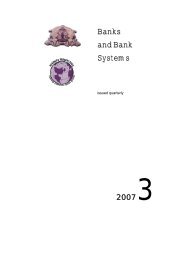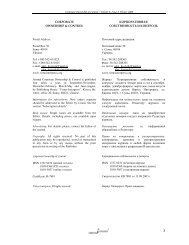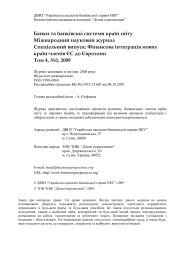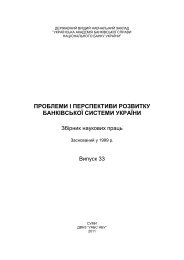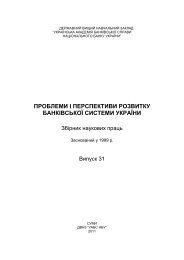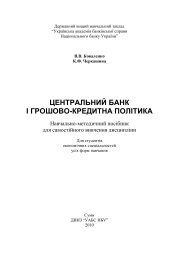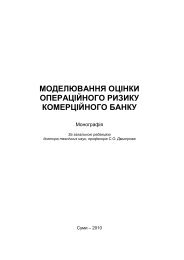BASEL II: PROBLEMS AND USAGE
BASEL II: PROBLEMS AND USAGE
BASEL II: PROBLEMS AND USAGE
You also want an ePaper? Increase the reach of your titles
YUMPU automatically turns print PDFs into web optimized ePapers that Google loves.
On the whole, the supervision system of the financial markets activity<br />
for many years had two multi-directed vectors of development. On the one<br />
hand, financial systems of different countries were very different and, as a<br />
result, the structure of the banking activity’s supervision system differed<br />
significantly, including the content and the character of supervisory bodies’<br />
responsibilities. On the other hand, the functioning of national banking systems<br />
during the last decades has been under considerable influence of integrative<br />
processes. Consequently it led to the necessity to solve the legislative<br />
problems in different countries and the creation of unified common<br />
banking regulation and supervision rules on the global market. It is often<br />
claimed that the striving for the creation of the common capital market is<br />
one of the main reasons for banking legislation unification. It is also an expression<br />
of the tendency in the development of the system of supervision<br />
over financial markets towards unified rules of supervision of banking,<br />
share market and insurance services market activity.<br />
The Committee on Banking Supervision plays a crucial role in the<br />
regulation of the banking activity. The necessity to ensure the stability of<br />
the banking system in the biggest countries of the world as well as the<br />
global banking system led in 1974 to the creation of the Committee on<br />
Banking Supervision by central banks and supervision authorities of the<br />
leading industrial states. The Committee usually meets at the Bank for International<br />
Settlements (BIS), which is situated in Basel, Switzerland. One<br />
of the main tasks of the Basel Committee is harmonization of the world<br />
practice of banking business regulation aimed at overcoming the differences<br />
between national practices, liquidating in such a way the main reason<br />
of regulative arbitrage.<br />
The acceptance of the International Convergence of Capital Measurement<br />
and Capital Standards (1988 Basel Capital Accord), more known as<br />
Basel I, in 1988 by leaders of ten central banks of economically developed<br />
countries became the first step to the harmonization of international banking<br />
regulation. In due course this agreement was endorsed in more than<br />
100 countries of the world. Actually it demonstrates the expediency and the<br />
necessity of using the generally acknowledged institutional limitations for<br />
banking activity regulation and it has really helped increase the stability of<br />
financial and banking system.<br />
The 1988 Basel Accord contained three main postulates: firstly, bank<br />
capital consists of the core capital and supplementary capital; secondly,<br />
banks have to maintain the amount of capital, sufficient to cover the credit<br />
risk; thirdly, at all times the target standard ratio of capital to weighted risk<br />
assets should be set at 8 per cent.<br />
8



